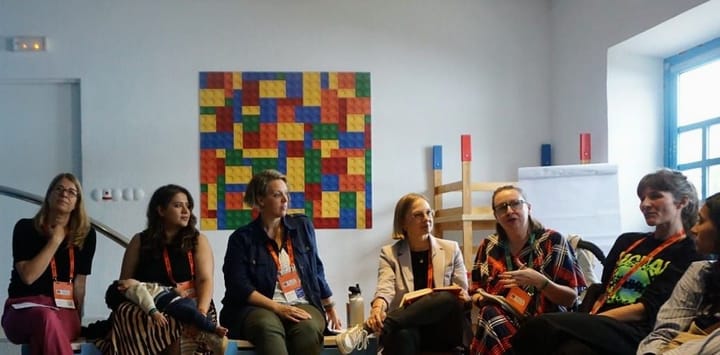Building an Open Prosocial Web

What if online platforms were designed to strengthen our social fabric? This week, in our main story, Audrey Tang—Taiwan’s Cyber Ambassador-at-Large, first Digital Minister, and a pioneer of civic tech—and IX’s Audrey Hingle explore how federated platforms can prioritize social cohesion.
But first...
Introducing “The Stack” – Internet Exchange’s New Bookshop
This week IX launched The Stack, a place to find hand-picked reading lists on internet governance, digital rights, and the intersection of technology and society. Plus, 10% of every sale supports our newsletter. Our debut list comes from the infrastructure reading group run by critical infrastructure lab: a bi-weekly meetup that explores the politics, values, and power dynamics embedded in communication infrastructures.
We asked Niels ten Oever, researcher at the University of Amsterdam and convenor of the reading group, to spotlight a few essentials for newcomers:
Technology of Empire, Balkan Cyberia, the Closed World [not available in our shop], and Reluctant Power are my favorite books from the reading group. It isn't an accident that these are historical books about infrastructures. They analyze power dynamics in communication networks when the dust has settled. Oftentimes, it is difficult to understand contemporary issues because of all the hype and obfuscation. This reading group taught me that to understand the present, we need to read about networks and technologies from the past, and not be blinded by claims about utopic or dystopian futures. Power and infrastructures are historically deeply entangled – the present is not as new as we tend to think!
The reading group meets online every other Tuesday at 16:00 CET; anyone can join or browse the public notes. Explore the full list, grab a copy now at The Stack, and find meeting details on the lab’s site.
Support the Internet Exchange
If you find our emails useful, consider becoming a paid subscriber! You'll get access to our members-only Signal community where we share ideas, discuss upcoming topics, and exchange links. Paid subscribers can also leave comments on posts and enjoy a warm, fuzzy feeling.
Not ready for a long-term commitment? You can always leave us a tip.
This Week's Links
Internet Governance
- The European Commission’s decision to fine Apple and Meta for breaching the Digital Markets Act (DMA) is a welcome move, says Article19. https://www.article19.org/resources/eu-fines-for-breaching-digital-markets-act-a-crucial-step-in-the-right-direction
- Interim U.S. attorney Ed Martin accused Wikipedia of enabling foreign propaganda and threatened its nonprofit status. https://www.theverge.com/news/656720/ed-martin-dc-attorney-wikipedia-nonprofit-threat
- Earlier this month, Bluesky restricted access to 72 accounts in Turkey at the request of Turkish governmental authorities, but there’s currently a loophole in its third-party apps. https://techcrunch.com/2025/04/23/government-censorship-comes-to-bluesky-but-not-its-third-party-apps-yet
- Paper by Public Knowledge discusses the need for a sector-specific digital regulator, and how to design one. https://publicknowledge.org/policy/building-the-digital-platform-commission-how-to-design-a-regulator-to-rein-in-big-tech
- At the 28th session of the United Nations Commission on Science and Technology for Development (CSTD), the Internet Society successfully advocated for the inclusion of community-centered connectivity. https://www.internetsociety.org/news/internet-society-at-the-cstd-28th-session
- The Global Cyber Alliance’s Domain Trust initiative is evolving into an “observatory of action” to collaboratively define and measure effective practices against domain abuse, following strong stakeholder support at its 13th community meeting. https://globalcyberalliance.org/domain-trust-dctm13
- Amid rising geopolitical tensions and distrust of the U.S. government under Trump, European businesses are increasingly exploring alternatives to American hyperscalers like AWS, Microsoft, and Google. https://www.theregister.com/AMP/2025/04/17/us_hyperscaler_alternatives
Digital Rights
- The European Commission presented an internal security strategy that would undermine digital rights and even increase security threats. EDRi unpacks what ‘ProtectEU’ means for the EU’s future digital policy, including on encryption, data retention, and border surveillance. https://edri.org/our-work/protecteu-security-strategy-a-step-further-towards-a-digital-dystopian-future
- A former Meta content moderator in Ghana suffered a severe mental health breakdown after repeated exposure to graphic violence. https://www.theguardian.com/technology/2025/apr/27/meta-content-moderator-breakdown-ghana
- New paper from Juilee Shivalkar and Azadeh Shahshahani finds governments worldwide are increasingly using counterterrorism laws to suppress social justice movements. https://socialchangenyu.com/harbinger/from-atlanta-to-kashmir-states-weaponize-counterterrorism-frameworks-to-target-social-justice-movements
Technology for Society
- Black tech entrepreneurs are building platforms to reclaim social media for Black ownership, community, and economic empowerment. https://www.forbes.com/sites/timekatounsel/2025/04/24/black-entrepreneurs-want-to-reclaim-social-media-for-the-culture
- In the latest Bellingchat Premium, Carlos Gonzales talks about his recent piece analysing the final moments of aid workers killed in Gaza. https://www.patreon.com/posts/what-audio-about-127433975
- Bluesky experienced a major outage due to DDoS attacks targeting its personal data servers (PDS), highlighting the platform’s current reliance on centralized infrastructure despite its decentralized ambitions. https://techcrunch.com/2025/04/24/wait-how-did-a-decentralized-service-like-bluesky-go-down
- Private group chats on encrypted apps like Signal, led by tech figures such as Marc Andreessen and Sriram Krishnan, have quietly shaped a powerful alliance between Silicon Valley elites and the political right, influencing U.S. discourse and strategy from behind the scenes. https://www.semafor.com/article/04/27/2025/the-group-chats-that-changed-america
- When pushed for credentials, Instagram's user-made AI Studio bots will make up license numbers, practices, and education to try to convince you it's qualified to help with your mental health. https://www.404media.co/instagram-ai-studio-therapy-chatbots-lie-about-being-licensed-therapists
Privacy and Security
- After the U.S. government announced a brief funding extension mid April, the CVE Foundation announced further plans to move from sole U.S. government funding to a globally supported, independent nonprofit model. https://www.thecvefoundation.org
- Text-generating AIs such as ChatGPT can be used to hide encrypted messages inside fake conversations, which could help people living under oppressive regimes communicate secretly. https://www.newscientist.com/article/2477243-chatbots-can-hide-secret-messages-in-seemingly-normal-conversations
- A U.S. security breach involving Defense Secretary Pete Hegseth has deepened concerns over the Trump administration’s lax digital security. https://www.foreignaffairs.com/united-states/real-lesson-signal-gate-pete-hegseth
- WhatsApp’s AI tools will use a new “Private Processing” system designed to allow cloud access without letting Meta or anyone else see end-to-end encrypted chats. But experts still see risks. https://www.wired.com/story/whatsapp-private-processing-generative-ai-security-risks
- IODA (Internet Outage Detection and Analysis) has released a new feature that enables users to view localized internet connectivity signals by country and region, even for networks operating across multiple areas. https://ioda.inetintel.cc.gatech.edu/reports/ioda-further-localizes-connectivity-signals
- Senior members of the World Uyghur Congress (WUC) living in exile were targeted with a spearphishing campaign aimed at delivering Windows-based malware capable of conducting remote surveillance against its targets. https://citizenlab.ca/2025/04/uyghur-language-software-hijacked-to-deliver-malware
- Researchers have uncovered a set of vulnerabilities, dubbed AirBorne, that allow hackers on the same Wi-Fi network to remotely execute code on millions of third-party Apple AirPlay-enabled devices. https://www.wired.com/story/airborne-airplay-flaws
Upcoming Events
- AI x Journalism Summit: Journalists, technologists and innovators will spend two days exploring how AI can enhance journalism and information. May 7-8, Baltimore MD. https://www.hackshackers.com/ai-x-journalism-summit-schedule
- IndieSky: a working group to build & run community-owned pieces of the AT Protocol stack. Free Our Feeds is supporting the effort with an initial donation. Join the working group! First call May 8, 9am PST. Online. https://atprotocol.dev/p/2c5705d3-8755-4be8-b386-557ccba31e94
- At the meeting “Memory safety in the EU”, leading organizations in the Secure by Design & Memory Safety space will gather to draft a statement outlining the importance of Memory Safety for Europe’s critical infrastructure and its urgency as part of Secure by Design policy. May 15, 9:30am CEST. Utrecht, Netherlands. https://rustweek.org/events/memory-safety-eu
- The Symposium on Information Controls brings together academic and civil society perspectives on information controls from around the world. May 16, 8:30am BST. London, U.K. https://kingsdh.net/2025/04/07/symposium-on-information-controls
- DNS has been bent to our will in a hundred creative ways, from static traceroutes to full protocols riding on top of it.Explore these bizarre & unusual uses at the ICANN Europe webinar with Peter Lowe. May 21, 12pm UTC. Online. https://www.icann.org/en/engagement-calendar/details/icann-webinar-series-for-europe-bizarre-and-unusual-uses-of-the-dns-2025-05-21
- 2025 Global Gathering is a three-day event focused on tech and human rights, bringing together global civil society, technologists, and funders to address censorship, surveillance, AI, and internet governance through participant-led sessions. September 8–10. Estoril, Portugal. https://www.digitalrights.community/blog/2025-global-gathering-application
- OARC45: Technical meeting hosted by DNS-OARC, focused on DNS operations, research, and analysis, bringing together experts to share updates and challenges in the DNS ecosystem. October 7–8. Stockholm, Sweden. https://indico.dns-oarc.net/event/55
Careers and Opportunities
- The Science of Agent Evaluation (SAgE) group at Princeton is hiring a Research Software Engineer (Part-Time). https://sage.cs.princeton.edu/job-ad.html
- IEEE Cybersecurity Award for Practice: Nominate individuals or small teams to recognize impactful, real-world contributions to cybersecurity by May 30. https://secdev.ieee.org/2025/awards
What did we miss? Please send us a reply or write to editor@exchangepoint.tech.
Toward a Prosocial Fediverse
By Audrey Tang and Audrey Hingle
In the recent research paper Prosocial Media, E. Glen Weyl, Luke Thorburn, Emillie de Keulenaar, Jacob Mchangama, Divya Siddarth, and Audrey Tang (co-author of this piece) propose a new approach to platform design that places social cohesion at the centre of online communication. The framework challenges the way most major platforms are currently designed; specifically, how they prioritize keeping users engaged by promoting content that drives clicks, often through outrage or controversy.
The paper argues that while social media platforms draw heavily on the “social fabric”, the network of relationships, affiliations and shared beliefs that structure human communities, they also often undermine it. This is especially true for platforms driven by advertising incentives, which are designed to maximise user attention through emotionally charged, often polarizing content. In contrast, the model proposed in Prosocial Media encourages algorithmic curation based on how well content bridges divides between communities, or fairly represents diverse perspectives.
The Role of Federated Platforms
Federated systems like Mastodon and Bluesky are often cited as promising alternatives to centralized platforms. Their decentralized architecture enables greater autonomy and diversity of governance models. However, we emphasize that decentralization alone isn’t enough. Decentralization changes who controls the infrastructure, but not how that infrastructure shapes social interaction. Without intentional design choices to support dialogue across communities, federated platforms risk replicating the same social fragmentation seen in their centralized counterparts. This makes the current phase of platform development especially significant. As many federated platforms like Bluesky remain in their early stages, there is an opportunity for communities to innovate their own governance solutions, and to embed prosocial principles into their infrastructure.
What’s Possible with a Prosocial Fediverse?
Current centralized social platforms often amplify division and lack transparency, creating a need for alternatives like "Prosocial Media" that are built in a different way, using decentralized systems that can connect and interact—but don’t rely on a central company—also known as federated principles.
This approach aims to foster understanding and societal health not by arbitrating truth, but by illuminating where people may agree and disagree. It helps make the social context of information visible to reveal "uncommon ground" and build stronger communities and collective resilience.
There is a tension between transparency and privacy. Federated systems try to respect context, empowering individuals and communities to control what data they share and helping them gain clarity within their chosen groups (e.g., "Here is what your communities X and Y agree on"). The goal is to go beyond connecting individuals, and instead nurture real communities through interoperable technology based on open protocols, requiring careful, iterative development to weave a healthier social fabric online.
Recommendations: Building a Prosocial Fediverse
To realize the promise of a healthier, more coherent digital public space, federated platforms should actively design for prosocial outcomes that strengthen the social fabric.
- Highlight content that bridges communities
Design algorithms that prioritize content supported by people from different communities or perspectives. This type of content can help reduce polarization and support shared understanding. Tools like Polis and Community Notes offer useful models for identifying and surfacing this kind of broadly supported content. - Label content with social context
Include labels or metadata that show which communities a piece of content appeals to or challenges. This kind of transparency helps users understand how content fits into broader conversations and reduces the false impression that certain views are universally accepted. - Encourage cross-community interaction
Create features that make it easier for people to encounter and engage with ideas outside their immediate circles. This could include curated feeds that show diverse viewpoints, prompts to explore related communities, or spaces for respectful dialogue across groups. - Support new and underrepresented communities
Provide tools and infrastructure that help smaller or emerging communities participate fully in the network. This might include discovery tools, moderation support, or funding models that help them grow and contribute meaningfully to the larger ecosystem. - Adopt shared standards for prosocial signals
To make these prosocial features work across the Fediverse, platforms should agree on common standards for things like content labels, community signals, and cross-platform feedback. Protocols like Spritely could help support this kind of interoperable infrastructure.
Embedding these principles into the DNA of federated platforms is a chance to reimagine the digital commons as a space where shared understanding, respectful disagreement and collective flourishing are not side effects, but core design principles.




Comments ()